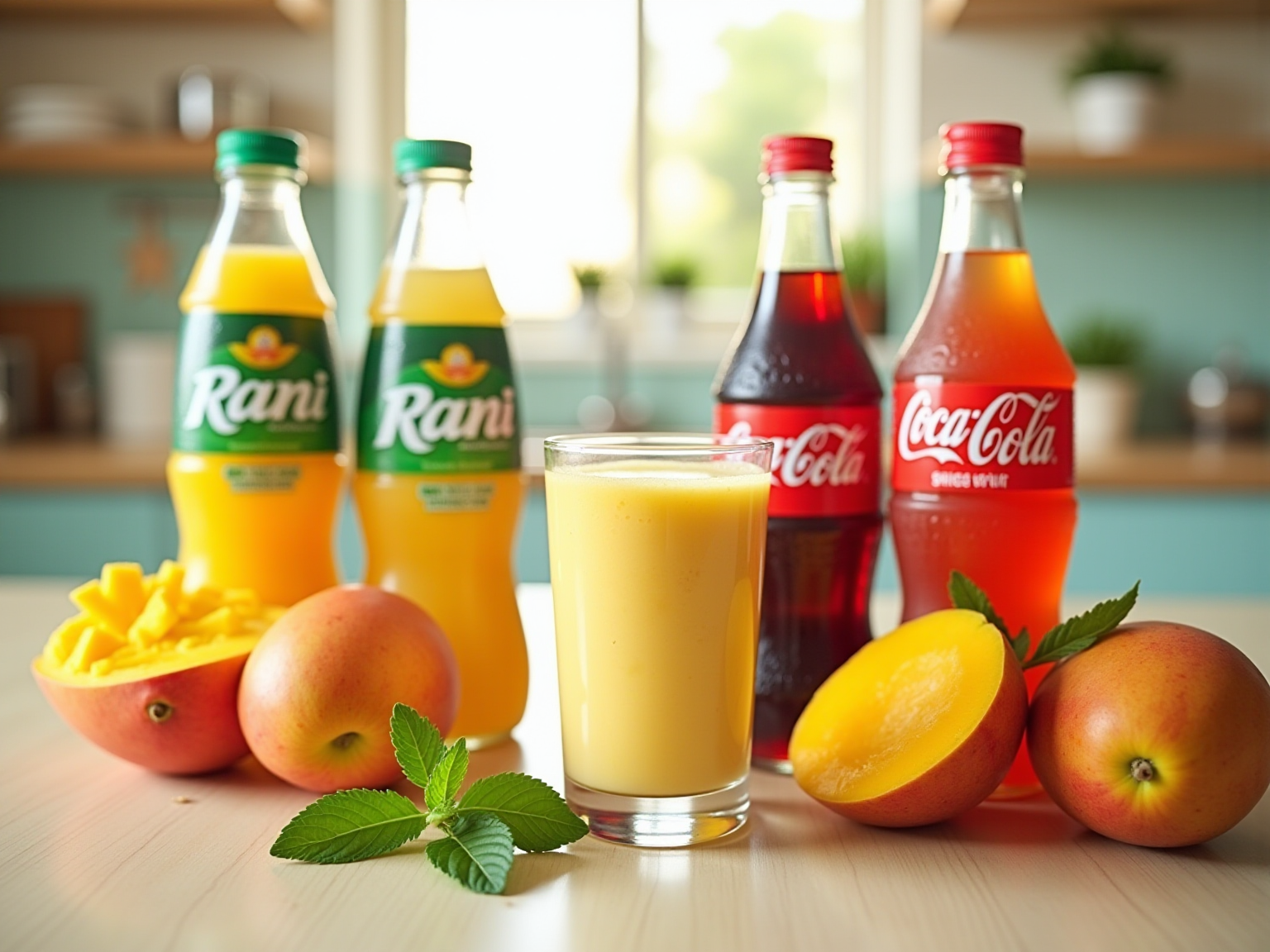General
What Are the 2025 Branding Trends for the UAE Food and Beverage Market? A Comprehensive Overview
Overview
The 2025 branding trends for the UAE food and beverage market underscore critical themes:
- Sustainability
- Personalization
- Technological integration
- Health consciousness
- Cultural localization
These trends are not merely passing fads; they are reshaping consumer preferences and redefining brand strategies. Companies that align their practices with these pivotal trends are not just adapting; they are strategically positioning themselves to cultivate customer loyalty and excel within a fiercely competitive landscape. This alignment is essential for brands aiming to thrive in the evolving market.
Introduction
The UAE food and beverage market is experiencing a transformative evolution, propelled by a unique blend of cultural diversity and a flourishing tourism sector. With consumer preferences increasingly shifting towards health-conscious and sustainable options, the market is set for remarkable growth, with per capita spending on food projected to surpass $3,900 by 2025.
This dynamic landscape is marked by local brands that resonate with cultural values, while international players adeptly adapt to meet local tastes. As dining out becomes more prevalent and the demand for innovative culinary experiences rises, a deep understanding of branding intricacies within this vibrant market is essential.
This article explores the current trends shaping the sector, underscores the significance of effective branding strategies, and highlights emerging practices that will define the future of food and beverage branding in the UAE.
Current Landscape of the UAE Food and Beverage Market
The growth and diversification of the UAE cuisine and beverage market are profoundly shaped by the 2025 branding trends, which mirror its multicultural population and a flourishing tourism sector. By 2025, the market is projected to achieve remarkable milestones, with spending on food and non-alcoholic beverages anticipated to surpass $3,900 per capita. This increase is propelled by a shift in consumer preferences toward health-conscious options, convenience, and premium products.
Local companies are gaining traction by resonating with cultural values, while international players are adapting their offerings to align with local tastes. The competitive landscape is marked by a strong emphasis on innovation, in line with the 2025 branding trends, as brands leverage technology and sustainability to distinguish themselves. Notably, Dubai experienced a 61% increase in dining out in 2023, with residents visiting restaurants nearly three times a week, underscoring the rising demand for diverse culinary experiences.
Key market players are concentrating on product innovations, strategic partnerships, and robust distribution networks to maintain a competitive edge. Recent market analyses, including PESTEL and Porter frameworks, offer valuable insights into the factors impacting market attractiveness and growth potential. These analyses illustrate how regulatory changes and economic conditions shape marketing strategies.
In this dynamic environment, effective marketing strategies must align with the 2025 branding trends for the UAE food and beverage market. This involves appealing to health-conscious individuals while also leveraging the unique cultural narratives that resonate with the UAE’s diverse demographic. As highlighted by a Senior Research Analyst at Cognitive Market Research, “Online grocery delivery services are expanding due to individuals’ convenient ability to order prepared meals and products online,” indicating a significant shift in purchasing habits that brands must consider.
Case studies reveal that the primary destinations for sugary soft drink exports from the UAE in 2024 included South Africa, Oman, and China, with China demonstrating the highest growth rate in export value. This emphasizes the necessity of understanding both local and international market dynamics to develop effective branding strategies that foster engagement and loyalty.
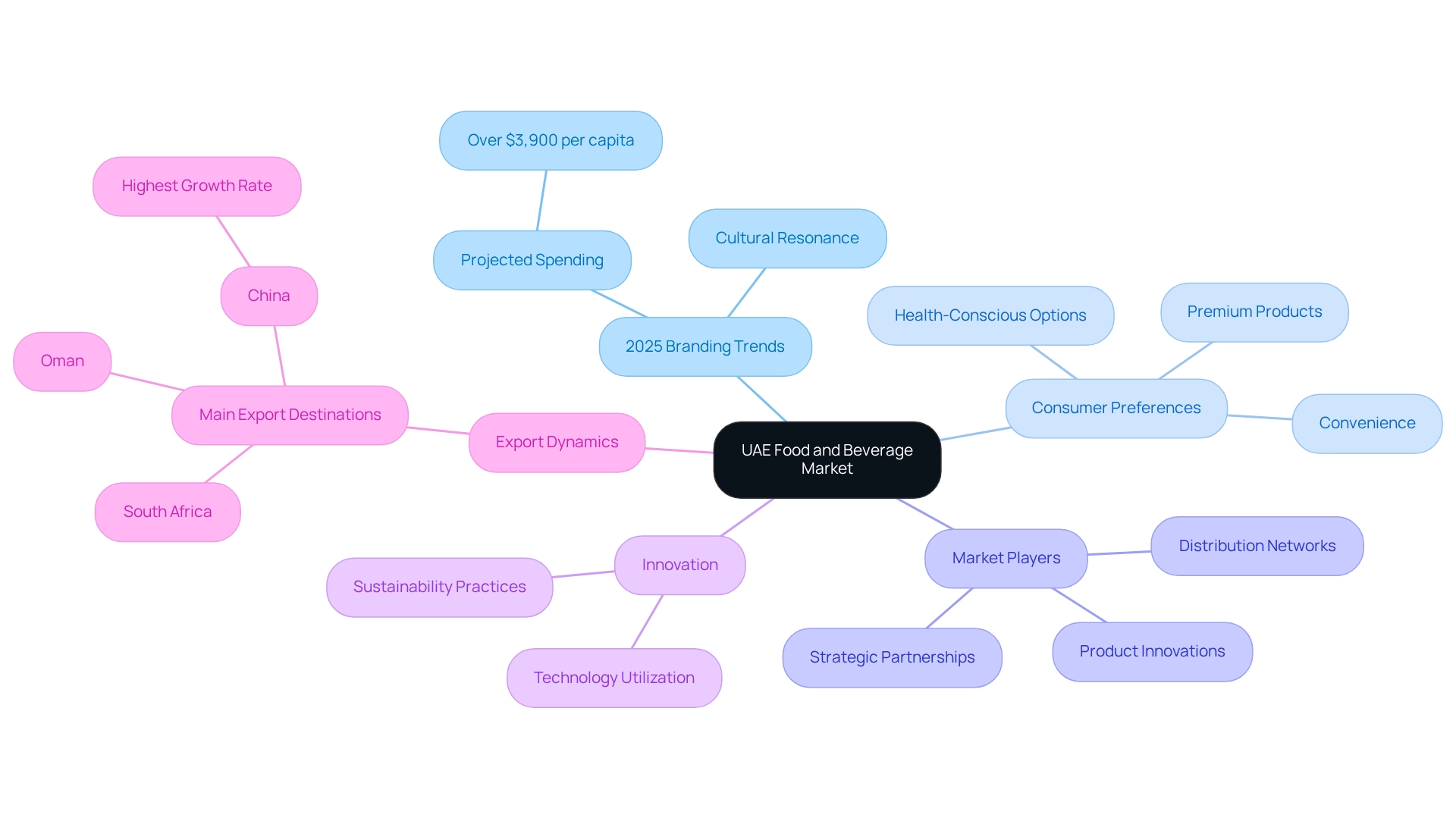
The Significance of Branding in the Food and Beverage Sector
Branding in the food and beverage industry is not merely an option; it is essential for establishing a unique identity that resonates with customers. A robust identity not only differentiates products in a saturated market but also cultivates emotional connections with consumers. In the UAE, where buyer preferences are increasingly sophisticated, companies that effectively communicate their values—such as quality, sustainability, and cultural relevance—are well-positioned to thrive, as indicated by the 2025 branding trends for the UAE food and beverage market.
For example, companies that prioritize local sourcing and sustainability are gaining favor among environmentally conscious consumers, signaling a significant shift toward ethical consumption.
Data underscores that successful marketing strategies can substantially enhance customer loyalty, leading to increased sales and a more formidable market presence. Notably, Nestlé was reported to have invested approximately 2.4 billion U.S. dollars in promotions across all channels in the United States in 2022. This investment illustrates the competitive nature of the beverage sector and underscores the importance of brand identity and promotion in strengthening market presence. Statista highlights this, noting that Nestlé is the largest advertiser in the U.S. cuisine and beverage sector.
The culinary industry has witnessed a remarkable surge in the consumption of cuisine-related content, with culinary videos on platforms like YouTube amassing nearly 51 billion views. This trend accentuates the importance of producing visually appealing and emotionally engaging content, such as images and videos, that resonate with diverse culinary experiences. Engaging culinary videos can attract viewers and foster a deeper connection with brands. WonderEight’s creative identity and digital advertising solutions, including media strategy and media purchasing, can empower businesses to leverage this trend to enhance their market presence.
Moreover, the impact of identity on customer loyalty within the UAE food and beverage industry is pivotal, particularly in light of the 2025 branding trends. Brands that effectively convey their commitment to quality and sustainability not only attract customers but also nurture long-term loyalty. As the market evolves, harnessing customer feedback becomes essential, enabling marketers to refine their promotional strategies to better meet audience needs.
Successful examples in the UAE showcase companies that have embraced innovative marketing strategies, emphasizing their unique identities while aligning with consumer values, consistent with the 2025 branding trends for the UAE food and beverage market. This alignment enhances recognition and fortifies customer loyalty, positioning identity as a critical factor in the competitive landscape of the culinary and beverage industry. Furthermore, service marketing plays a crucial role in generating brand recognition, boosting sales, and advocating for nutritious and sustainable meal choices, further underscoring the vital role of identity in this sector.
With WonderEight’s comprehensive identity solutions, businesses can navigate these challenges and excel in a dynamic market.
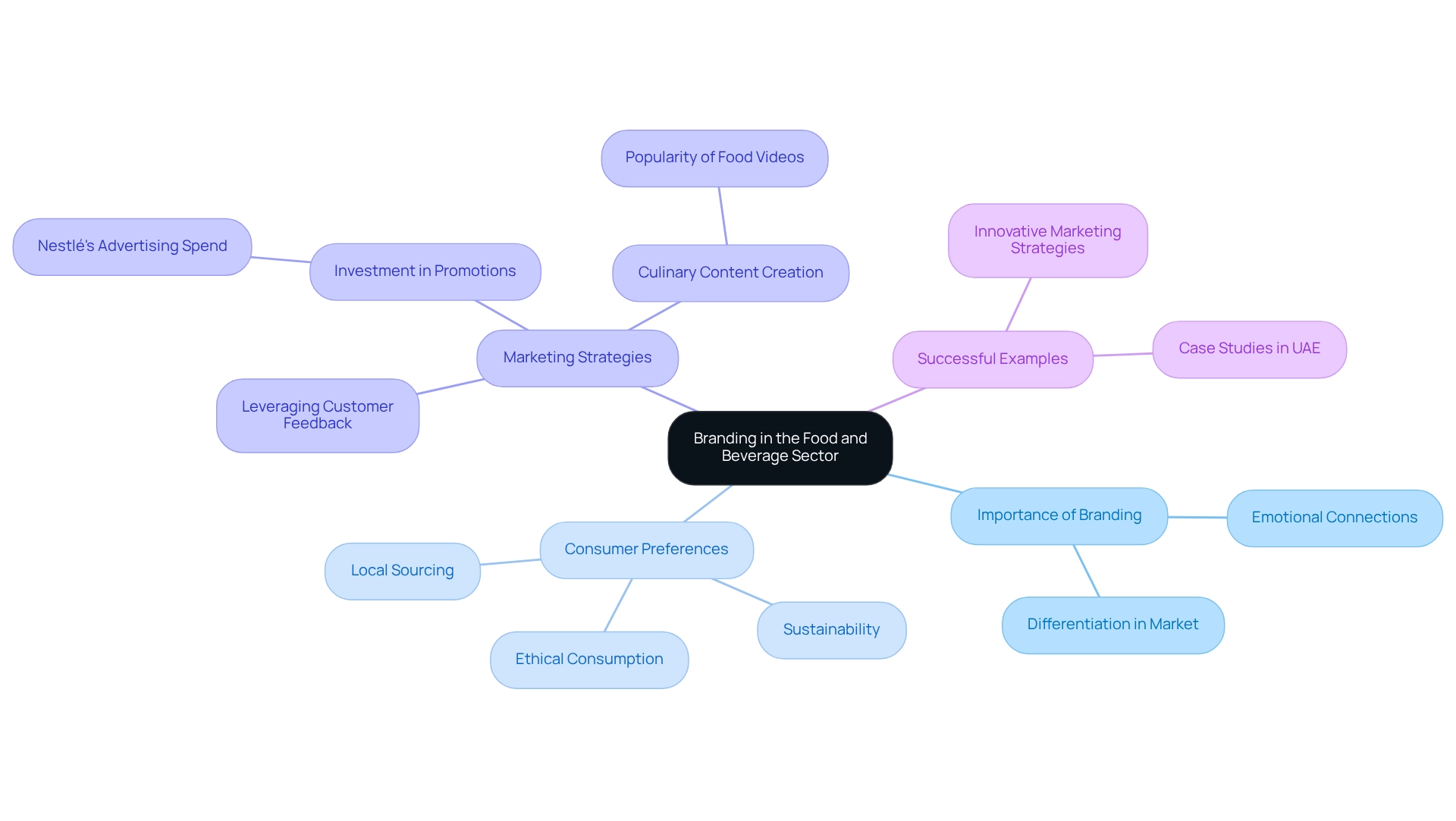
Emerging Branding Trends for 2025
As we approach 2025, the UAE beverage market is undergoing significant transformations, driven by emerging branding trends. Sustainability has become a fundamental expectation among consumers, who increasingly favor brands demonstrating a commitment to environmental responsibility. This shift is underscored by the UAE’s rising self-sufficiency ratio in agricultural production, which increased from 12.8% in 2016 to 16.4% in 2021, particularly in dairy products, where the ratio peaked at an impressive 35.5%.
Brands that align their messaging with sustainable practices are poised to resonate more effectively with environmentally conscious consumers. A case study on the UAE’s self-sufficiency in food production exemplifies how companies can strategically align with sustainability efforts to meet customer expectations.
Personalization emerges as another pivotal trend, as companies harness data analytics to tailor their offerings to individual preferences. This approach not only enhances customer satisfaction but also fosters loyalty. Furthermore, the integration of technology into marketing strategies is gaining traction, with innovations such as augmented reality experiences and interactive packaging that engage consumers in unique ways.
The rise of online grocery delivery services, as highlighted by a Senior Research Analyst at Cognitive Market Research, underscores the critical role of technology in shaping buyer behavior and preferences.
Health and wellness remain paramount, with companies increasingly promoting functional foods that cater to the growing demand for nutritious options. This trend reflects a broader shift among consumers towards healthier lifestyles, prompting brands to emphasize the health benefits of their products. Moreover, storytelling is becoming an integral component of marketing strategies.
Brands are now focusing on authentic narratives that resonate with consumers on a deeper emotional level, reflecting their core values and mission. This trend holds particular significance in the UAE, where cultural narratives profoundly influence buyer perceptions.
In summary, the 2025 branding trends for the UAE food and beverage market are characterized by a pronounced emphasis on sustainability, personalization, technological integration, health consciousness, and compelling storytelling. Additionally, the rise of subscription products and mobile grocery shopping further illustrates the technological advancements reshaping the market. Brands that adeptly leverage these trends will be positioned to excel in an increasingly competitive landscape.
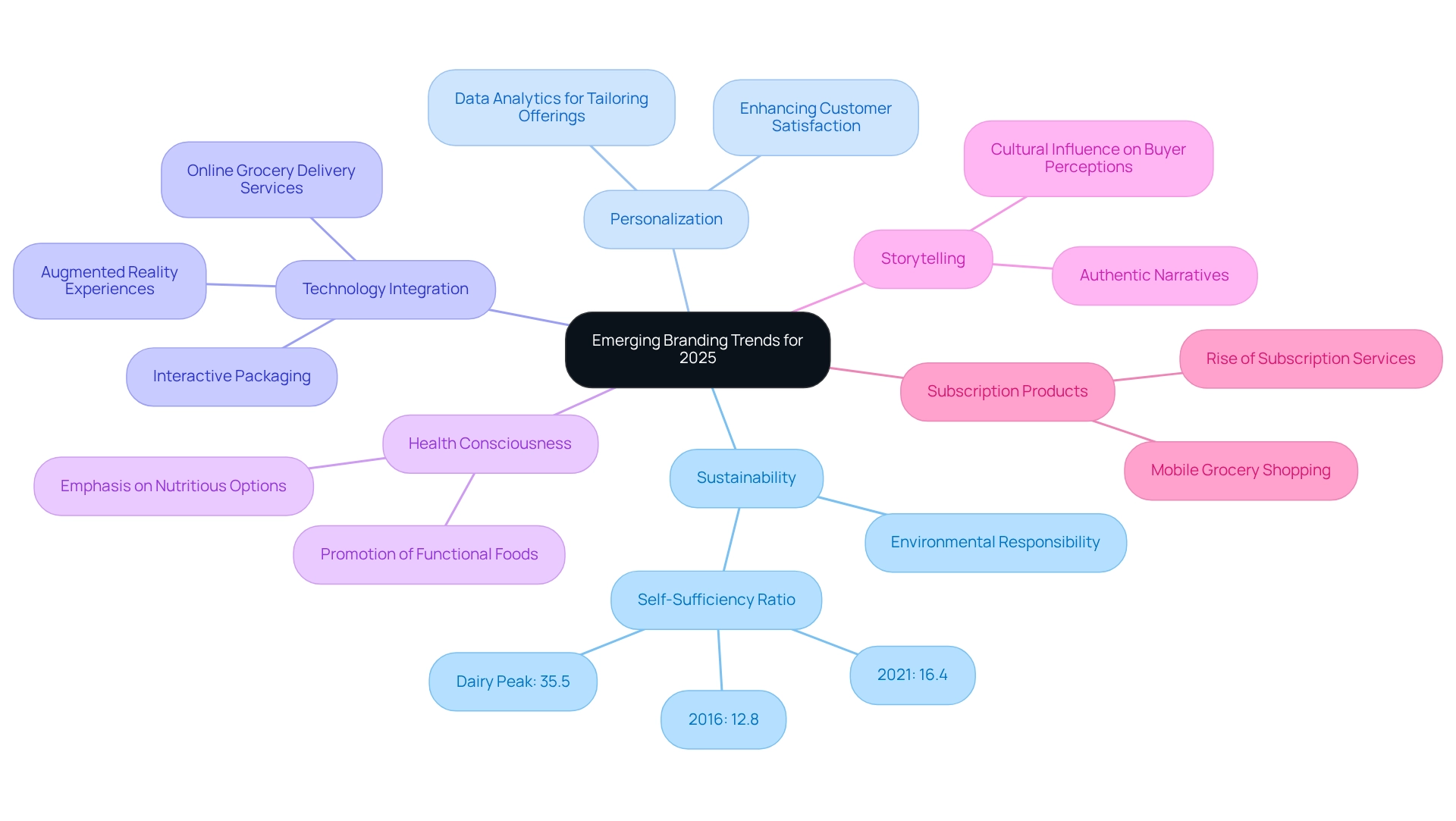
Sustainability as a Core Branding Element
Sustainability has emerged as a pivotal factor in the 2025 branding trends for the UAE food and beverage market, signaling a significant shift in public awareness regarding environmental impacts. As consumers increasingly prioritize sustainable practices, companies demonstrating a commitment to responsible sourcing, waste reduction, and eco-friendly packaging are gaining substantial traction. For instance, businesses that implement zero-waste initiatives or strive for carbon neutrality are often perceived more favorably, fostering customer loyalty and enhancing their market reputation.
Statistics indicate that a considerable number of individuals in the UAE actively seek sustainable food options, with many willing to pay a premium for products that align with their values. Notably, Black Mamba sources ingredients from approximately 90 smallholders, exemplifying the practical application of sustainable practices within the industry. This trend underscores the imperative for companies to weave sustainability into their core identity; those that neglect this responsibility risk losing competitive advantage.
Case studies further illustrate successful sustainable practices within the sector. For example, the Grace Farms Foundation’s initiative, Grace Farm Foods, partners with women-led cooperatives and Fairtrade producers, donating 100% of profits to enhance labor conditions. Such initiatives not only promote ethical sourcing but also resonate with consumers who are increasingly conscious of the social and environmental ramifications of their purchasing decisions.
This aligns with findings from the NYU Stern Center for Sustainable Business, which emphasizes the financial significance of sustainability in business management and performance.
As the demand for sustainable food companies continues to escalate, it is essential for organizations to recalibrate their marketing strategies in line with the 2025 branding trends for the UAE food and beverage market. Expert insights reveal that consumers are not merely searching for products; they are seeking brands that embody their values and contribute positively to society. Al Gore’s assertion that we need systems that serve both people and the environment reinforces the ethical considerations that resonate deeply with consumers.
In this evolving landscape, sustainability transcends mere trend status; it has become a fundamental expectation that can profoundly impact brand loyalty and market success. Furthermore, Eileen Fisher’s call for a universal approach to sustainability in fashion highlights the growing recognition of sustainability as a critical aspect of identity across various sectors.
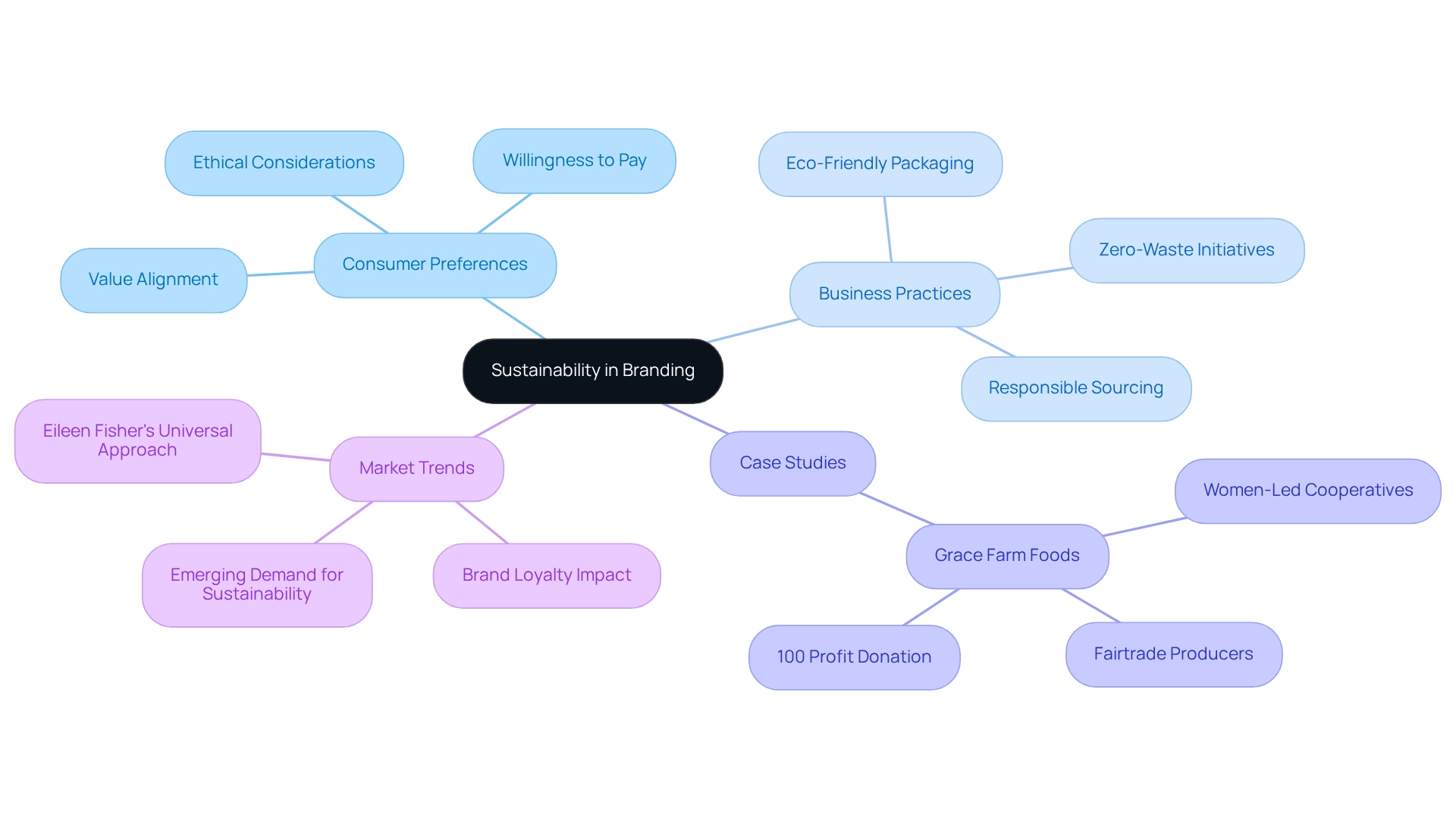
The Influence of Technology on Branding Strategies
Technology is fundamentally reshaping the 2025 branding trends for the UAE food and beverage market. The integration of digital marketing tools, social media platforms, and e-commerce solutions empowers companies to engage with clients in increasingly effective and efficient ways. For instance, the use of data analytics has become essential for comprehending buyer behavior and preferences, enabling companies to craft highly targeted marketing campaigns that resonate with their audience.
Moreover, the rise of mobile applications and online ordering systems has transformed customer interactions with businesses, making convenience a pivotal factor in purchasing decisions. This evolution underscores the necessity for companies to recalibrate their strategies to align with the shifting expectations of consumers.
Digital transformation offers significant advantages, including streamlined production, enhanced supply chain management, and improved customer satisfaction—elements crucial for firms striving to excel in a competitive marketplace. Innovative technologies, such as blockchain, are also gaining momentum in the industry, bolstering transparency in sourcing and production processes. This heightened openness not only fosters trust in companies but also cultivates customer loyalty, as consumers increasingly gravitate towards businesses that prioritize ethical practices and clear communication.
As a global marketing and digital agency, WonderEight excels in innovative marketing strategies tailored to the unique needs of the beverage and culinary sectors. Their proficiency in leveraging digital tools and data-driven insights positions them as a pivotal player in guiding companies through the complexities of modern advertising.
A notable illustration of technology’s influence on marketing strategies is the Leave of Absence Campaign by Saatchi & Saatchi Middle East, which harnessed digital platforms to confront a significant social issue. This campaign not only heightened awareness but also exemplified how technology can be utilized to foster meaningful conversations and corporate change. As the food and beverage market in the UAE continues to evolve, grasping the 2025 branding trends will be vital for brands seeking to maintain a competitive edge and effectively engage with their target audience.
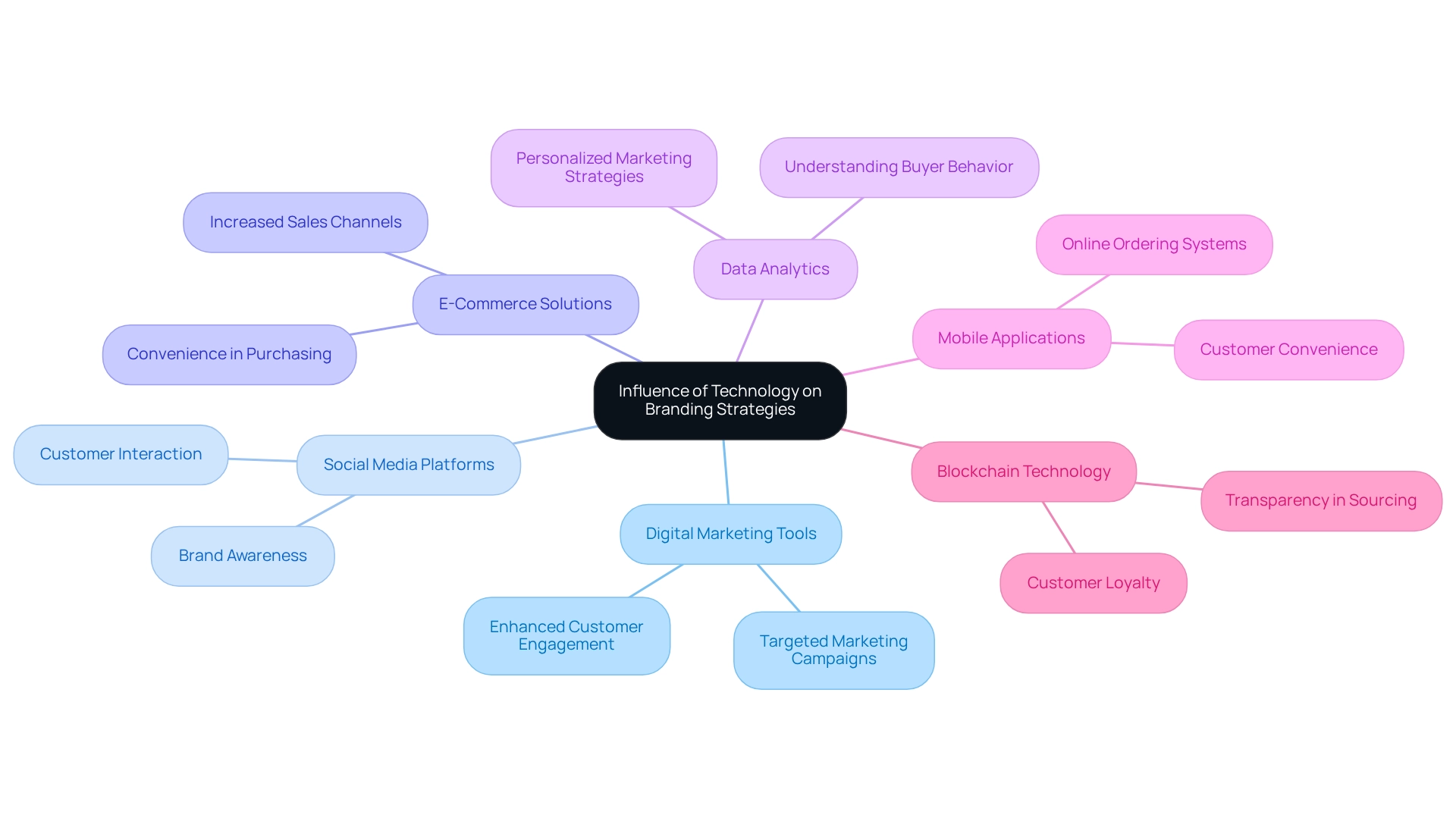
Cultural Localization in Branding
Cultural localization is crucial in shaping the 2025 branding trends for the UAE food and beverage market, a nation distinguished by its diverse population and rich cultural heritage. Brands that adeptly tailor their messaging, products, and marketing strategies to align with local customs and preferences stand a greater chance of resonating with consumers. This process transcends mere language translation; it necessitates a deep understanding of cultural values, dietary restrictions, and customer expectations.
For instance, food companies that provide halal options or incorporate traditional local flavors into their offerings significantly enhance their appeal to the Emirati market.
In the context of evolving eating habits, effective communication strategies are paramount. Brands must harness social media and media planning to craft content that mirrors contemporary dietary trends and consumer interests. This involves producing captivating photos and videos that resonate with local audiences, thereby amplifying brand visibility and connection.
WonderEight emphasizes the importance of these strategies in navigating the shifting landscape of culinary advertising.
A notable example of successful localization is IKEA, which initially encountered obstacles when entering the Japanese market due to furniture dimensions that did not cater to local preferences. However, by localizing their products and in-store experience, they effectively addressed local needs. This underscores the necessity of adapting branding to local customs, as illustrated by the 2025 branding trends for the UAE food and beverage market.
By prioritizing cultural adaptation and employing strategic media communication in accordance with the 2025 branding trends for the UAE food and beverage market, companies not only cultivate stronger connections with customers but also foster loyalty and trust—essential components for enduring success in this dynamic market. Successful case studies highlight that maintaining consistency while adapting to local nuances is vital; companies must strike a balance between the need for localization and the preservation of their core identity. As detailed in the case study titled ‘Maintaining Brand Consistency,’ this strategic approach not only meets customer demands but also positions brands advantageously within the competitive landscape of the UAE beverage industry, reflecting the 2025 branding trends for the UAE food and beverage market.
Furthermore, Abdulaziz Karam asserts that the authors’ holistic model enriches localization literature by providing evidence for the significance of stereotypes and employability as critical constructs to be examined alongside localization experiences and retention. This perspective underscores the necessity for companies to integrate cultural elements into their marketing strategies, particularly as they adapt to the evolving preferences of consumers. The updated advertising regulations demand a nuanced understanding of these dynamics, ensuring that companies remain relevant and appealing in a rapidly changing market.
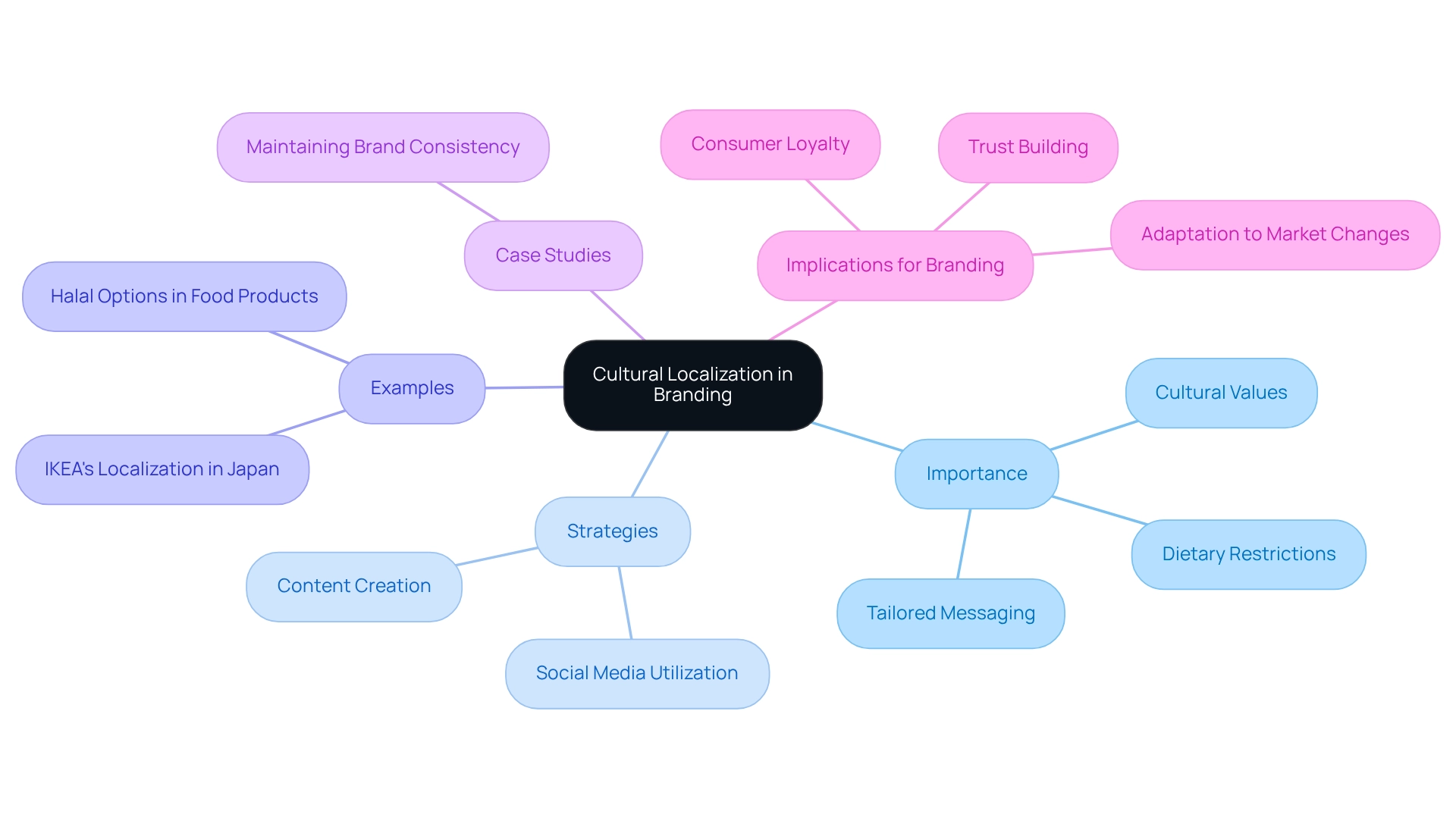
Interactive and Smart Packaging Trends
Interactive and intelligent packaging is emerging as a pivotal trend in the food and beverage sector, providing brands with innovative avenues to connect with consumers. Technologies such as QR codes, augmented reality (AR), and Near Field Communication (NFC) are increasingly being integrated into packaging, facilitating interactive experiences that enhance user engagement. These advancements empower users to access a wealth of information about products, including sourcing details, nutritional facts, and promotional offers, directly through their smartphones.
This approach not only elevates the client experience but also cultivates a stronger bond between companies and their patrons. By embracing these technologies, businesses can differentiate themselves in a competitive marketplace, creating memorable interactions that foster customer loyalty. The trend of smart homes and connected devices further amplifies this engagement, enabling individuals to interact with packaging in innovative ways that enhance functionality.
In the UAE, the integration of smart packaging technologies aligns with the 2025 branding trends for the UAE food and beverage market, as consumers increasingly seek transparency and interaction from the labels they choose. For instance, the adoption of smart labels and eco-friendly materials is gaining momentum, reflecting the rising demand for sustainability. As highlighted by Peter Voortmans, Commercial Director of Consumer Products Flexibles at Borealis, “This new rLLDPE grade is a significant step towards a circular economy for plastics because of its remarkable 85% post-consumer recyclate content.”
This underscores the critical importance of sustainable practices in packaging.
Moreover, the UK government’s recent investment of £60 million in sustainable packaging projects emphasizes the growing significance of eco-friendly materials and smart labels, which are pertinent to the UAE market. As the market evolves, companies that leverage the 2025 branding trends for the UAE food and beverage sector are poised to experience enhanced consumer engagement and improved loyalty, positioning themselves for success in 2025 and beyond. Notably, WonderEight’s extensive campaigns for brands like Miranda and Quaker Oats illustrate how effective promotional strategies can harness interactive packaging trends, showcasing real-world applications and results.
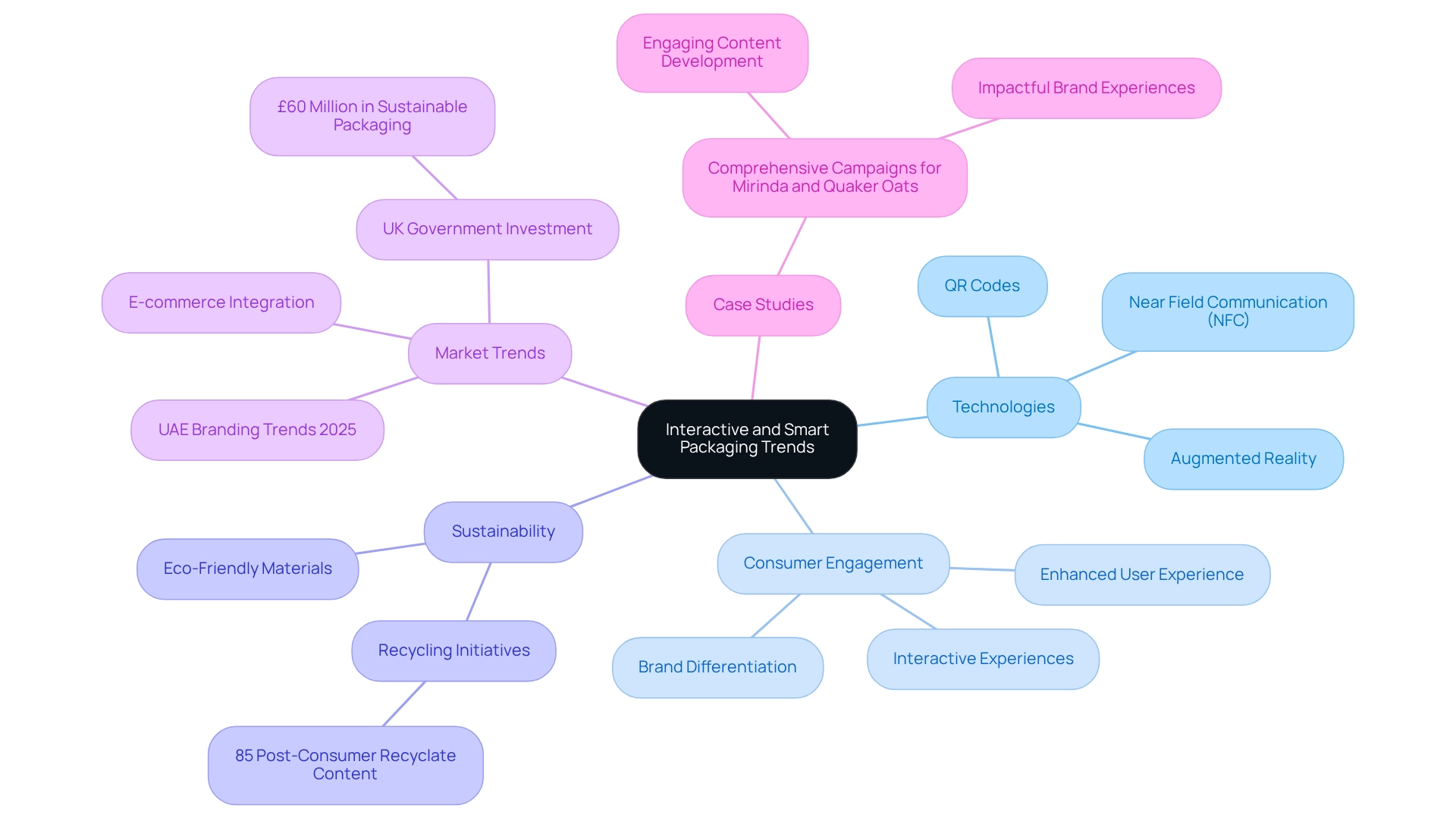
Key Takeaways and Future Implications
Several crucial trends are significantly shaping the marketing landscape for the UAE food and beverage sector in 2025. Sustainability has emerged as a cornerstone of company identity, with consumers increasingly favoring businesses that demonstrate a commitment to environmentally friendly practices. This shift transcends mere trend status; it is a necessity. Companies prioritizing sustainability are poised to connect more profoundly with discerning consumers.
Technology plays a pivotal role in shaping marketing strategies. The integration of digital tools empowers companies to create personalized experiences that foster genuine connections with their audience. As the market evolves, the demand for transparency in marketing intensifies, with buyers seeking clarity about sourcing and production processes.
Statistics reveal that a substantial share of shoppers now favors labels that transparently express their practices, reflecting a broader movement toward health-aware and organic food selections.
Cultural adaptation is another critical element of effective marketing in the UAE. Brands that customize their messaging and offerings to align with local customs and preferences are better positioned to engage with customers. Tapan Vaidya, Treasurer at UAE and CEO of Papa John’s, emphasized this point, stating that the UAE is emerging as a global gastronomy hub.
Significant initiatives, such as the Youth Young Chef Challenge at Gulfood 2025, underscore the importance of fostering local talent and innovation in the culinary sector, further highlighting the necessity for companies to engage with their cultural foundations.
Looking ahead, the implications of the 2025 branding trends for the UAE food and beverage market are substantial. Organizations that adapt their strategies to embrace sustainability, technological advancements, and cultural awareness will not only enhance their market presence but also cultivate long-term loyalty among customers. Additionally, Dubai’s ambition to double the number of large-scale events hosted annually from around 300 today to over 600 by 2033 illustrates the growing opportunities for brands to engage meaningfully with their audience, aligning with the 2025 branding trends for the UAE food and beverage market. In summary, the future of branding in this sector will be defined by a commitment to innovation, cultural relevance, and sustainability.
Brands that embrace these elements will thrive in an increasingly competitive landscape, ensuring they meet the evolving expectations of consumers.
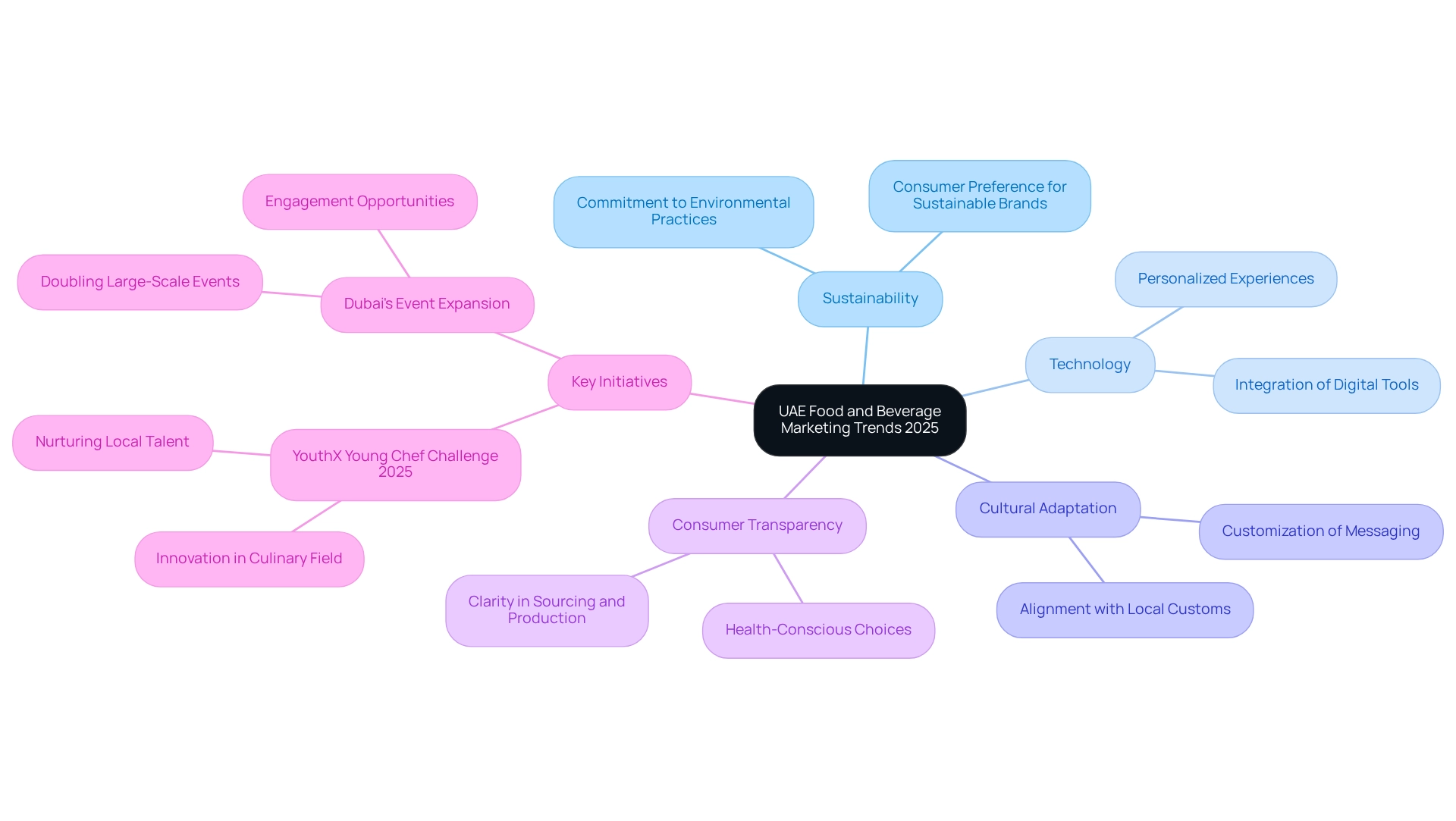
Conclusion
The UAE food and beverage market is on the cusp of a significant transformation, propelled by emerging trends that prioritize sustainability, technology, and cultural localization. As consumer preferences increasingly lean towards health-conscious and environmentally responsible options, brands that integrate sustainability into their core identity are poised to cultivate deeper connections and loyalty among discerning consumers. The market’s growth trajectory, with per capita spending projected to exceed $3,900 by 2025, underscores the necessity of adapting branding strategies that resonate with evolving consumer values.
The influence of technology is paramount, as brands harness digital tools and data analytics to craft personalized experiences that engage consumers effectively. The emergence of interactive and smart packaging exemplifies this trend, presenting innovative avenues for brands to connect with their audience and enhance transparency. Furthermore, cultural localization remains essential in a diverse market like the UAE, where customizing messaging and products to reflect local customs can significantly amplify brand appeal.
Looking forward, the implications of these trends are profound. Companies that prioritize sustainability, embrace technological advancements, and maintain cultural relevance will position themselves advantageously in a competitive landscape. As Dubai aspires to elevate its status as a global gastronomy hub, the opportunities for brands to engage meaningfully with consumers are bound to expand.
In conclusion, the future of branding in the UAE food and beverage sector is set for remarkable evolution. Brands that focus on innovation, cultural sensitivity, and sustainability will not only thrive but also foster lasting loyalty in a market that increasingly values authenticity and responsibility.
Frequently Asked Questions
What factors are shaping the UAE cuisine and beverage market by 2025?
The UAE cuisine and beverage market is being shaped by branding trends that reflect its multicultural population and a growing tourism sector. Key factors include a projected increase in spending on food and non-alcoholic beverages, shifting consumer preferences towards health-conscious and premium products, and a strong emphasis on innovation and sustainability.
What is the projected per capita spending on food and non-alcoholic beverages in the UAE by 2025?
By 2025, spending on food and non-alcoholic beverages in the UAE is anticipated to surpass $3,900 per capita.
How are local and international companies adapting to the UAE market?
Local companies are resonating with cultural values, while international players are adapting their offerings to align with local tastes. This includes focusing on product innovations and strategic partnerships to maintain a competitive edge.
What recent trends have been observed in dining habits in Dubai?
In 2023, Dubai experienced a 61% increase in dining out, with residents visiting restaurants nearly three times a week, indicating a rising demand for diverse culinary experiences.
What marketing strategies are important for the UAE food and beverage market?
Effective marketing strategies must align with the 2025 branding trends, appealing to health-conscious individuals while leveraging unique cultural narratives. Brands should also focus on online grocery delivery services to cater to changing purchasing habits.
What insights do recent market analyses provide regarding the UAE food and beverage market?
Recent market analyses, including PESTEL and Porter frameworks, highlight how regulatory changes and economic conditions impact market attractiveness and growth potential, influencing marketing strategies.
What role does branding play in the food and beverage industry in the UAE?
Branding is essential for establishing a unique identity that resonates with customers, differentiating products in a saturated market, and cultivating emotional connections. Companies that communicate values like quality and sustainability are better positioned to thrive.
How has consumer behavior shifted towards ethical consumption in the UAE?
There is a growing preference for local sourcing and sustainability among environmentally conscious consumers, indicating a significant shift towards ethical consumption.
What impact do culinary videos have on consumer engagement?
Culinary videos on platforms like YouTube have seen nearly 51 billion views, underscoring the importance of visually appealing and emotionally engaging content that resonates with diverse culinary experiences and fosters brand connections.
How can businesses enhance their market presence in the UAE food and beverage sector?
Businesses can enhance their market presence by embracing innovative marketing strategies, effectively conveying their commitment to quality and sustainability, and leveraging customer feedback to refine their promotional strategies.


